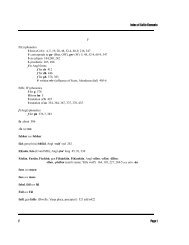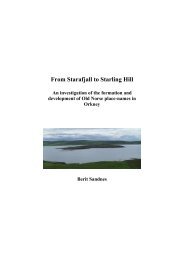May Williamson: The Non-Celtic Place-Names of the Scottish Border ...
May Williamson: The Non-Celtic Place-Names of the Scottish Border ...
May Williamson: The Non-Celtic Place-Names of the Scottish Border ...
Create successful ePaper yourself
Turn your PDF publications into a flip-book with our unique Google optimized e-Paper software.
97<br />
ROXBURGHSHIRE<br />
ACREKNOWE (Cav): (85, 12 B):<br />
Akarknowe 1547-8 CSP; Akerknow, Blaeu. Perhaps OE æcer, “cultivated land”, is <strong>the</strong> first<br />
element, as “hill with a cultivated patch”. Rxb dialect aiker, “sharp, keen, pointed”, applied to<br />
<strong>the</strong> face (Watson, s.v.), is possible, since <strong>the</strong> hill above Acreknowe is sharply pointed to <strong>the</strong><br />
North. Fr aigre must be <strong>the</strong> source <strong>of</strong> this word.<br />
HUMMELKNOWES (Cav): (85, 12 B):<br />
Homble Knowes, 1547-8 CSP; Humilknowis, 1574 RPC. ModSc hommyll, humble, “hornless,<br />
dodded”, is used <strong>of</strong> a round hill: cf Humbledon Hill, Du, and Humbleton Hill, Nb (PN NbDu,<br />
120). For Humbleton, YER, OE *humol, “something rounded”, related to OE hamel,<br />
“maimed”, is suggested (PN YER, 54).<br />
/241/<br />
MIDDLESKNOWES (Oxn): is so spelt in 1590, CBP. <strong>The</strong> first element may be an OE<br />
personal name *Midele: cf Middlesborough and Middlesmoor, YWR (PN YNR, 160).<br />
BERWICKSHIRE<br />
COWDENKNOWES (Earl): (81, 2 C):<br />
Coldaneknollis, 1535 RSS; Coldounknowis, 1541 ALC; Coldinknollis, 1559 LSMM;<br />
Coldenknovis, 1581 Dryb. This may be a hybrid, Gael colltuinn, “hazel”, and MSc knowe, as<br />
Pr<strong>of</strong>essor Watson argues (CPNS, 139), but it may also be an English formation: OE col-denu,<br />
“charcoal valley”, with cnolles. Compare Great Cowden: Coledun, 1086; Coldun 12 th , from<br />
OE col-dun (PN YER, 62). Cowdenknowes is in an area previously well wooded, so that<br />
charcoal may well have been produced <strong>the</strong>re.<br />
DUMFRIESSHIRE<br />
CROWDIEKNOWE HILL (Mid):<br />
Crowdi(e)know, 1648, 1655, Reg Sas Dmf. MSc crowdie is a kind <strong>of</strong> cheese, but this is<br />
unlikely to be <strong>the</strong> first element <strong>of</strong> a hill-name. An OE personal name Crūda, as in<br />
Crowdycote, Db, is possible (DEPN, 127).<br />
MOSSKNOW (KF):<br />
Mouseknow, Blaeu. Blaeu’s spelling is perhaps incorrect. OE mos, MSc moss, “bog, moss”,<br />
may be <strong>the</strong> first element.<br />
A “lost” name is Brunecnolh, 1165-75 LSMM, in Hownam, which is “brown hillock”.<br />
/243/ <strong>The</strong>re are 154 o<strong>the</strong>r names in -knowe. Very few are farm-names: practically all denote<br />
hills. <strong>The</strong>y are to be found in more or less equal proportions in <strong>the</strong> four counties.<br />
/244/ LXVI MSc rigg,<br />
“long narrow hill, ridge”, is a dialect form, ei<strong>the</strong>r directly borrowed from ON hryggr, or<br />
representing OE hryċġwith consonants influenced by <strong>the</strong> Scandinavian word. Endings in<br />
-ridge are modern substitutions.




